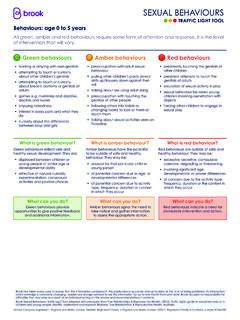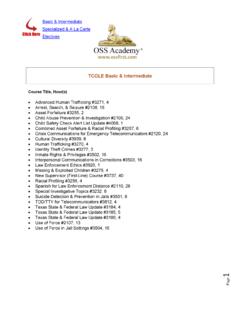Transcription of (2015-03-25) Working Together to Safeguard Children
1 Working Together to Safeguard Children A guide to inter-agency Working to Safeguard and promote the welfare of Children March 2015 2 Contents Introduction 5 About this guidance 6 What is the status of this guidance? 6 Who is this guidance for? 7 A child-centred and coordinated approach to safeguarding 8 Chapter 1: Assessing need and providing help 12 Early help 12 Identifying Children and families who would benefit from early help 12 Effective assessment of the need for early help 13 Provision of effective early help services 14 Accessing help and services 15 Information sharing 16 Assessments under the Children Act 1989 17 The purpose of assessment 19 The principles and parameters of a good assessment 21 Focusing on the needs and views of the child 23 Developing a clear analysis 24 Focusing on outcomes 25 Timeliness 26 Local protocols for assessment 27 Processes for managing individual cases 28 Chapter 2.
2 Organisational responsibilities 52 Section 11 of the Children Act 2004 52 Individual organisational responsibilities 55 Schools and colleges 55 Early Years and Childcare 56 Health Services 56 police 58 Adult social care services 58 3 Housing services 59 British Transport police 59 Prison Service 60 Probation Service 60 The secure estate for Children 61 Youth Offending Teams 62 UK Visas and Immigration, Immigration Enforcement and the Border Force 62 Children and Family Court Advisory and Support Service 62 Armed Services 63 Voluntary and private sectors 63 Faith Organisations 64 Chapter 3: Local Safeguarding Children Boards 65 Statutory objectives and functions of LSCBs 65 LSCB membership 67 LSCB Chair, accountability and resourcing 70 Information sharing 71 Chapter 4: Learning and improvement framework 72 Principles for learning and improvement 73 Notifiable Incidents 74 Serious Case Reviews 75 National panel of independent experts on Serious Case Reviews 76 Chapter 5: Child death reviews 81 Responsibilities of Local Safeguarding Children Boards (LSCBs) 81 Responsibilities of Child Death Overview Panels 84 Definition of preventable child deaths 85 Action by professionals when a child dies unexpectedly 85 Appendix A: Glossary 92 Appendix B.
3 Statutory framework 95 Children Act 2004 95 Education Acts 96 Children Act 1989 96 4 Legal Aid, Sentencing and Punishment of Offenders Act 2012 101 police Reform and Social Responsibility Act 2011 101 Childcare Act 2006 101 Crime and Disorder Act 1998 101 Housing Act 1996 102 Table A: Bodies and individuals covered by key duties 102 Appendix C: Further sources of information 106 Supplementary guidance on particular safeguarding issues 106 Supplementary guidance to support assessing the needs of Children 108 Supplementary guidance to support the Learning and Improvement Framework 108 5 Introduction Local authorities have overarching responsibility for safeguarding and promoting the welfare of all Children and young people in their area.
4 They have a number of statutory functions under the 1989 and 2004 Children Acts which make this clear, and this guidance sets these out in detail. This includes specific duties in relation to Children in need and Children suffering, or likely to suffer, significant harm, regardless of where they are found, under sections 17 and 47 of the Children Act 1989. The Director of Children s Services and Lead Member for Children s Services in local authorities are the key points of professional and political accountability, with responsibility for the effective delivery of these functions. Whilst local authorities play a lead role, safeguarding Children and protecting them from harm is everyone s responsibility.
5 Everyone who comes into contact with Children and families has a role to Safeguarding and promoting the welfare of Children is defined for the purposes of this guidance as: protecting Children from maltreatment; preventing impairment of Children 's health or development; ensuring that Children grow up in circumstances consistent with the provision of safe and effective care; and taking action to enable all Children to have the best outcomes. Local agencies, including the police and health services, also have a duty under section 11 of the Children Act 2004 to ensure that they consider the need to Safeguard and promote the welfare of Children when carrying out their functions.
6 Under section 10 of the same Act, a similar range of agencies are required to cooperate with local authorities to promote the well-being of Children in each local authority area (see chapter 1). This cooperation should exist and be effective at all levels of the organisation, from strategic level through to operational delivery. Professionals Working in agencies with these duties are responsible for ensuring that they fulfil their role and responsibilities in a manner consistent with the statutory duties of their employer. 1 In this document a child is defined as anyone who has not yet reached their 18th birthday. Children therefore means Children and young people throughout.
7 6 About this guidance 1. This guidance covers: the legislative requirements and expectations on individual services to Safeguard and promote the welfare of Children ; and a clear framework for Local Safeguarding Children Boards (LSCBs) to monitor the effectiveness of local services. 2. This document replaces Working Together to Safeguard Children (2013). Links to relevant supplementary guidance that professionals should consider alongside this guidance can be found at Appendix C. What is the status of this guidance? 3. This guidance is issued under: section 7 of the Local Authority Social Services Act 1970, which requires local authorities in their social services functions to act under the general guidance of the Secretary of State; section 10(8) of the Children Act 2004, which requires each person or body to which the section 10 duty applies to have regard to any guidance given to them by the Secretary of State; section 11(4) of the Children Act 2004 which requires each person or body to which the section 11 duty applies to have regard to any guidance given to them by the Secretary of State.
8 Section 14B(7) of the Children Act 2004, which states that LSCBs must, in exercising their functions in respect of obtaining information, have regard to guidance given to them by the Secretary of State; section 16(2) of the Children Act 2004, which states that local authorities and each of the statutory partners must, in exercising their functions relating to LSCBs, have regard to any guidance given to them by the Secretary of State; section 175(4) of the Education Act 2002, which states that governing bodies of maintained schools (including maintained nursery schools), further education institutions and management committees of pupil referral units must have regard to any guidance given by the Secretary of State.
9 Paragraph 7(b) of the Schedule to the Education (Independent School Standards) Regulations 2014, made under sections 94(1) and (2) of the Education and Skills Act 2008, which states that the arrangements to Safeguard or promote the welfare of pupils made by the proprietors of independent schools (including academies or 7 free schools) or alternative provision academies must have regard to any guidance given by the Secretary of State; and paragraph 3 of the Schedule to the Education (Non-Maintained Special Schools) (England) Regulations 2011, made under section 342 of the Education Act 1996, which requires arrangements for safeguarding and promoting the health, safety and welfare of pupils in non-maintained special schools to have regard to any guidance published on such issues.
10 4. This guidance applies to other organisations as set out in chapter 2. It applies, in its entirety, to all schools. 5. This document should be complied with unless exceptional circumstances arise. Who is this guidance for? 6. This statutory guidance should be read and followed by local authority Chief Executives, Directors of Children s Services, LSCB Chairs and senior managers within organisations who commission and provide services for Children and families, including social workers and professionals from health services, adult services, the police , academy trusts, education, youth justice services and the voluntary and community sector who have contact with Children and , 3 7.












